|
FAQs on Anemone Identification
38
Related Articles: Anemones,
Bubble
Tip Anemones, LTAs,
Cnidarians, Coldwater Anemones, Colored/Dyed Anemones,
Related FAQs: Anemone ID 1, Anemone ID 2, Anemone ID 3,
Anemone ID
4, Anemone ID 5, Anemone ID 6,
Anemone ID 7,
Anemone ID 8, Anemone ID 9, Anemone ID 10,
Anemone ID 11,
Anemone ID 12, Anemone ID 13, Anemone ID 14, Anemone ID 15,
Anemone ID 16, Anemone ID 17, Anemone ID 18, Anemone ID 19,
Anemone ID 20, Anemone ID 21, Anemone ID 22, Anemone ID 23, Anemone ID 24, Anemone ID 25, Anemone ID 26, Anemone ID 27, Anemone ID 28, Anemone ID 29, Anemone ID 30, Anemone ID 31, Anemone ID 32,
Anemone ID
33, Anemone ID 34, Anemone ID 35,
Anemone ID 36,
Anemone ID 37, Anemone ID 39, Anemone ID 40, Anemone ID 41,
Anemone ID 42,
Anemone ID 43, Anemone ID 44,
Anemone ID 45,
&
Cnidarian
Identification,
|
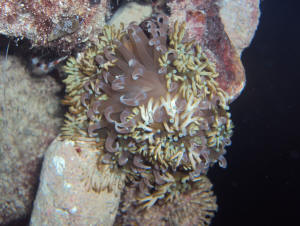
An aberrant Lebrunia
|
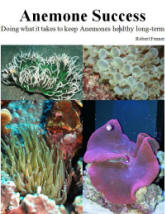 |
New Print and
eBook on Amazon:
Anemone Success
Doing what it takes to keep Anemones healthy long-term
by Robert (Bob) Fenner
|
|
Anemone Identification - Sebae?
12/2/10
Hello, and thank you in advance. You have been of help for
me in the past, and I want to thank you all for the time
you donate to help others, such as myself.
Your site has been a huge resource and has been so
helpful.
<Very glad that we have helped you>
I purchased this anemone for a very big discount at my pet
store. He had been there two months. He was so white, he
looked like glass...see-through. His size initially, was
about 1.5" across and he was flat, without much of an
extension where his tentacles are. The petstore helper said
that he had no idea what
it was, but it had arrived as a Sebae, but had not had a
good time...he discounted it for $10 if I wanted it, and I
took the thing home.
Well, he has grown, and his coloration is increasing,
slowly, and I have had him about 3 months. He is now a
light pinkish purple, with bright blue tips.
<I see this... unusual coloring>
I would like to see his tentacles get longer, but they
don't seem to and they don't seem to be full as the
bubble tipped anemone I have had in another system.
This little thing is about 4" across, maybe 5",
now and it is not white anymore,
but it's still not dark, either.
<Will likely continue to
change, intensify/darken with time>
My system is under 250w HQI 20k lighting. He is
approximately 1 foot from that bulb, and he is also given
T5 lighting, as a supplement, only the actinics, as I need
to purchase new 14k t5ho bulbs for the other two, however
it is helping...not as fast as I'd like to see it, but
he looks improved.
I don't have any pictures of when he arrived, however,
I have some photos I snapped today which I'd like your
opinion on.
I have been through your entire site. I read all the
differences I could find between the H. Crispa and H. Malu.
I still can't identify him properly and in order to get
him the right clownfish, I'd like to have an idea what
type I should be searching out...I don't particularly
like the Clarkii, so I am hopeful he can accept other
types.
<Yes, can>
I was thinking of a skunk pair...but let's see what you
determine him to be, and go from there.
<I do think this is a Heteractis crispa, a
"Sebae" as you state>
His tips aren't pink, they are blue.
<At least they are "dotted" at the tips; a
definitive characteristic>
His coloration is a very light lavenderish-tan,
<As I say, strange to me>
and he lives on top of the reef, and has finally adjusted
to the lighting after all this time, just this month. His
hiding days are gone, thank goodness. He, at first, soaked
up light, and then went into the reef and I
was afraid he had died, but he came out earlier this month
and continues eating Krill and Mysis Shrimp, and he is now
up near the light, soaking and enjoying it.
<Good>
I see him spread out more. My Maroon ignores him, although
she swims over and looks...she prefers my frogspawn over
him, therefore I am pretty sure it's a Sebae, but I
really value your opinion.
Thank you again, and I hope that you can help me identify
him.
Photo #1 is the anemone from the top of the tank, showing
his coloration, because the flash bleaches him out
somewhat.
<Ah yes>
Photo #2 is from the side of the tank and yes, I see the
algae behind him...I am picking it out soon as I get this
photo out to you! Lol. :)
Renee
<Thank you for sharing. Bob Fenner>
|
|
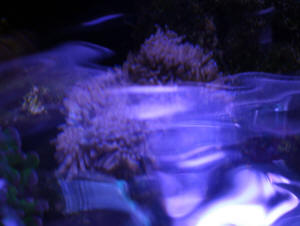 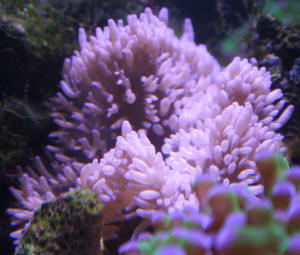
Re: Anemone Identification
- Sebae?
1/28/11
Hello,
<Hi there>
I wanted to send another update as to the anemone.
It's now January 27.
This is the anemone today.
My question is: he is really sticky now when I feed
him. Is this normal?
I cannot locate any other Sebaes like this online.
<Not normal for the species... and this may well not
be Heteractis crispa>
Is this a normal coloration and is this indeed still a
Sebae? He lives on top of my reef right under the 250
HQI 20k bulb.
I have had him since September, 2010.
Thank you in advance for answering additional
questions.
Renee
PS- New image attached.
<Can you send along some images of the basal disc
(foot), pedicle (stalk)? Bob Fenner> |
|
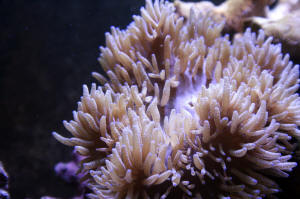
|
|
Re Anemone ID
1/28/11
Hi Bob,
<FD>
You sent me a request to see the foot of my Sebae and
here are the best images I can take. I would include
the other letter, but for some reason, I can't
find it.
<No worries>
As you notice, I have included an additional close-up
of the tentacles to help as well.
I am pretty sure it's a Sebae, but I am not
finding many with this coloration.
<I do NOT think this is H. crispa... these lack
the verrucae evident on your specimen... and the
tentacle size, markings are all wrong>
When I sent my note last night, I thought I had it
since September, but looking at images, I found out
it's since late July, 2010, so we have had it
around six months, and its recovery has been very
slow.
He eats Krill and Mysis shrimp so I don't think
they are causing the coloration.
<May well be influencing>
He is very lavenderish with a grayish brown tint.
Thank you once again...am looking forward to your
diagnosis.
Renee
PS- What is H. Aurora and why am I not finding
anything on it in here, whereas online I am finding
many things about it? Is it the same as Malu or
Crispa?
<No... Please read here: http://wetwebmedia.com/beadanemfaqs.htm
and here:
http://wetwebmedia.com/marine/inverts/cnidaria/anthozoa/anemones.htm
and do the long read and possibly send your pix to
Daphne Fautin at her site:
http://hercules.kgs.ku.edu/hexacoral/anemone2/index.cfm
Bob Fenner, who clearly does NOT know what Actinarian
this is>
|
|
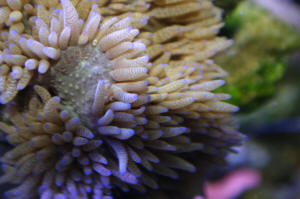 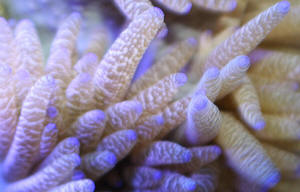
|
Re: Anemone ID 1/28/11
Well thank you very much Bob. I thought it looked
different. Well whatever it is, it's improved from
see-through and flat to a nice looking nem with
color.
Thank you so much for the information. I read through
the articles ... no possibility it's dyed, because
it looked like milk glass when I got it. :)
Renee
<I do wonder what this animal is though!
B> |
Re I need some
information for an Anemone ID - Bob Fenner
Referral 1/31/11
Here is the information and my note from the person you
referred me to.
Her answer is included below as well as my letter to her
regarding my H. Crispa.
<Okay! Thank you and Daphne (hello!). BobF>
Thank you Bob for your help and I am sad that I can never
possibly provide the best home for him, but I am doing what
I can. I wish we weren't in California and/or the sea
it came from was near so I could let it go. It's so sad
to see these beautiful creatures dying so frequently in
well-meaning hobbyist homes. I
think if everyone stopped buying them, they'd stop
shipping them, but there's little/no chance of that
happening.
I rescued it and it is alive and surviving. Maybe someday
it will have longer tentacles. I am adding some 10k T5HO to
the system today. Maybe this will give it a bit more light.
Just to survive, this guy wants 2 krill every morning,
super bright light, absolutely crystal clean water without
any readings and water changes every 7 days like clockwork.
Without those, he looks pekid.
I will do my best for it. I hope it survives. :)
Thank you and WWM for all the help,
Renee
From: Daphne Fautin
Subject: Re: I need some information for an Anemone ID -
Bob Fenner Referral 1/31/11
Dear Renee,
Knowing precisely what species of anemone you have is
probably unimportant in being able to care for it properly.
Of course, I am not an aquarist -- I am a field biologist
and a taxonomist of sea anemones. I prefer to see the
animals where they live so I can understand how they live.
No matter how much we
try to emulate that environment in captivity, we will fall
short in some way because we do not have all the species,
all the chemicals, all the water motion, all the weather,
etc. in our tanks.
It seems to me that many of the shallow tropical anemones
that host Clownfishes live in pretty much the same types of
habitats, and so probably eat pretty much the same thing
and have similar physical requirements.
As to what you have, what is it about the animal that Bob
Fenner make your possible identification of it as
*Heteractis crispa* wrong? The tentacles are patterned,
which is atypical, but specimens from the Red Sea may have
such patterning.
<<Mmm, I strongly doubt this animal was harvested
from the RS. VERY few come to the west from there.
RMF>>
The main feature that distinguishes the species is the
leathery column (the source of the species name, and of
course not something I can judge) and the large verrucae
(warts) on the upper column, in longitudinal rows, which
this seems to have, to judge by your photos. These
tentacles seem short for the species, but that may be
because of the conditions you described. Indeed, typically
individuals kept in captivity have shorter tentacles than
individuals of the same species in nature: sea anemone
tentacles grow from the base and cells die at the tips, so
the length is determined by the ratio in timing of the two
processes. The short tentacles of captive-kept anemones
reflects to me that they are not thriving -- their
tentacles are not growing as much before the tip cells die
as in nature. It is one of the indicators I use to back up
my claim that something is missing -- and by this I do not
mean that aquarists are doing something wrong or are
mistreating their animals. It is just that humans cannot
provide something the animals need, and I do not want to
see more animals taken (so they do not contribute to the
next generation of anemone or homes to
the next generation of Anemonefishes) in what I consider to
be a misguided effort to "solve" the problem. It
might never be solved, and even if it is, how many animals
have to die in the process?
Sincerely,
Daphne G. Fautin
Professor, Ecology and Evolutionary Biology
Curator, Natural History Museum and Biodiversity Research
Center
Haworth Hall
University of Kansas
1200 Sunnyside Avenue
Lawrence, Kansas 66045-7534 USA
direct to database of Hexacorals, including sea
anemones
newest version released 22 December 2010
***http://hercules.kgs.ku.edu/Hexacoral/Anemone2***
> Hi,
> I know you must be busy, but I was referred to you by
Bob Fenner, who had no
> idea what kind of anemone I have. He has asked me to
send you images. So, I
> have uploaded them to Flickr, and you can see them
there. I thought this was
>H. crispa, but he says everything is wrong. So, maybe
you can help me out finding
> answers, so I can properly care for it. I have had it
since July, 2010. It was
> in a local pet store. I got him for ten dollars,
because he had lost all
> coloration and was white/glassy and had no tentacles.
Basically, the poor thing
> was an oral disk, and I think it might have been
dying, but it has taken a lot
> of care, lighting and it has come back somewhat. Here
are images of my
> anemone. I'd certainly appreciate your expertise,
as I have no clue what I've got.
> You can view the images I uploaded at
http://www.flickr.com/photos/fishdeeva/
> Thank you sincerely,
> Renee
|
|
Anemone
ID 11/17/10
Hello Crew,
<Howsit Kris?>
I was wondering if you can help me identify my anemone. I
purchased it form a reputable online retailer as a
Stichodactyla haddoni.
<Mmm, don't think so. See here: http://wetwebmedia.com/carpetanemones.htm
When I opened the bag it was small and brown and a good
sight at first that it wasn't white or transparent.
While I was drip acclimating it I was reading a post on a
well known forum about if there was any trace of
ammonia in the bag to expedite it and place in the tank. I
checked the water in the bag and it was at 3.0 mg/l.
Checked mine and it was 0.0. So while I was trying to
unattach it from the bag ever so carefully I noticed that
there was very noticeable verrucae and snapped a quick pic
before I placed him in the tank. I posted all of this on
that forum to try and get a positive ID but have come up
with conflicting responses. We have come up with the
following: a Atlantic carpet, a gigantea or a
mertensii.
<The latter is my guess>
The little guy is maybe 4 inches in diameter purplish oral
disk with green tentacles. The picture that
shows the verrucae was taken in my kitchen with the anemone
in a small Tupperware hence why it all looks tannish. The
oral disk looked the same color tan while it was in the
kitchen and now its more purple in the tank.
Lighting is 2-250w phoenix 14k bulbs and the anemone is
being shaded by three layers of window screen to acclimate
it to the lighting. Is there any way you help paint a
clearer picture.
Thanks,
Kris
<Enjoy! Bob Fenner>
|
|
.jpg) .jpg)
|
|
Sand tentacles..
11/4/10
Hi!,
<Hi Gregory>
Thanks so much for all your help. WWM is amazing and I
enjoy reading your responses.
<Thank you>
I was hoping for some identification help. I have had a 90
gallon aquarium up and running for several years. From time
to time later in the evening when my lights transition from
MH to only T5's and on into
night time, I will see clear almost transparent tentacles
emerging from the sand. I do have a DSB of 5" to
7", I don't know why but I first thought Aiptasia,
but I don't think I'm on the right track (its seems
to not like the light).
<This is difficult to see, but could easily be Aiptasia,
and would be my guess>
Recently, I was able to get a photo of one that is next to
the glass (attached). I hope you can see the distance the
tentacles are extending. Sometimes the base or trunk
extends higher than the turbo shell in the background.
Thanks again!!
<No problem>
Greg C.
<Simon>
|
|
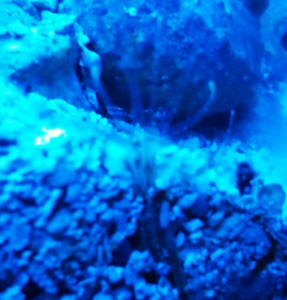
|
|
Re: Sand
tentacles.. worm
11/10/10
Hey crew!
<Hey Gregory, sorry it has taken a few days. Am snowed
under at the moment and will be out for a while>
Leave it up to the wife, she found out what my the sand
tentacles were.
They are Polychaete worms.
<Really? Did not look like it to me, but ok>
Terebellid is what she is saying, but uuhhh after
confirming what she found out, I found a
perfect example at http://www.wetwebmedia.com/WormIDF15.htm
titled "**Identification Weird tentacle sand worm" Are these guys anything to
worry about?
<Nah. Are beneficial life forms, contributing to the
plankton in your system, and the clear-up of
detritus>
I seem to have quite a bit of them.
<Will ‘wax and wane’ with your system, feeding
patterns, maintenance etc.>
Thanks again for all your help....
<No problem, Simon>
|
|
ID please? Maybe
Feather duster? 10/24/10
Hello,
<Serj>
First of all thank you so much for a great site, especially
to Simon who has been very knowledgeable and patient with
my crypt problem...
<Ahh, seems to "be out presently">
I need help ID'ing a creature in my tank. I am very
leery of Aiptasia because of my long war with them (which I
believe I won, haven't seen them for over a month) so I
ended up using Aiptasia X on this new life in my tank that
came on the live rock that came with my Bubble Tip
Anemone...it looked like a brown Aiptasia at first but with
my battle with the Aiptasia I had never seen it form this
hard tube stuff. After I sprayed with the Aiptasia X the
top "head" part was gone, but the hard
"body" was left. I was concerned that I killed
possible a cool looking feather duster...anyways today I
noticed more of this stuff is growing...can you please help
ID or at least confirm that it is not Aiptasia so I can
stop being concerned about it...will this critter be an
issue for my BTA?
<Mmm, don't know... possibly. Read the below
citation>
I do not want to start a chem. war because they are only
inches apart and both live n the same live rock.
I apologize for the quality of pictures...
--
Thank you,
Sergey Sagan
<I think this is another species of
anemone/Actinarian.
http://wetwebmedia.com/marine/inverts/cnidaria/anthozoa/twaanemones.htm
Lebrunia... Bob Fenner>
Re: ID please? Maybe Feather
duster?
10/24/10
Ohh I apologize I forgot to mention in those pics, there
are three "colonies" pictured. The two on the
left (middle on being the biggest) are dead (the ones I
used Aiptasia X on) only the right one the smallest
"colony" is alive...not sure if that
helps...thanks for your reply and even on
Saturday!
<I see/saw two of these; may be different anemone spp...
and Sunday here currently. BobF>
|
|
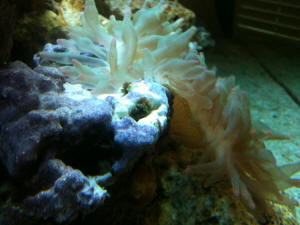 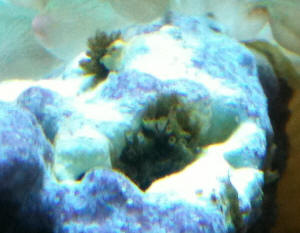
|
|
anemone
identification
9/17/10
<...15 megs in pix...>
I came across an anemone I have never seen before. Found it
under a rock 7 miles off shore. Anyone have any idea what
it may be?
<... offshore from where?>
It seams to like shrimp pieces (like most anemones) It
reacts to a flashlight being shown on it. (shrinks up) It
has small patches of fork shaped arms all over it and also
has long curled arms everywhere. I cant find a pattern to
the way its arms are laid out. I'm very confused.
lol!
Thanks,
Ed Johnston
<Oh! I take it from your addy that you're in Key
West... I think this is an "aberrant" Lebrunia
danae. Bob Fenner>
|
 |
|
Re: anemone
identification 9/18/10
You are correct! I researched the name and came up with
some great pics that match. Thanks a lot!
Ed
<Welcome Ed. BobF>
|
|
|
|

